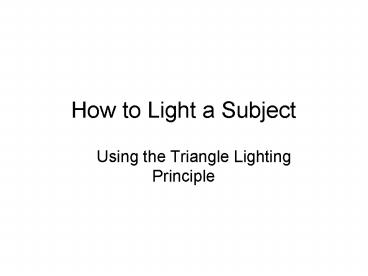How to Light a Subject - PowerPoint PPT Presentation
Title:
How to Light a Subject
Description:
How to Light a Subject Using the Triangle Lighting Principle How to Light a Subject Using the Triangle Lighting Principle The Triangle Lighting Principle consists ... – PowerPoint PPT presentation
Number of Views:153
Avg rating:3.0/5.0
Title: How to Light a Subject
1
How to Light a Subject
- ? Using the Triangle Lighting Principle
2
The Triangle Lighting Principle consists of three
primary light sources.
Click the name of the light source to learn more
about it.
Back light
Fill light
Key light
3
It reveals the basic shape of an object or
subject and creates heavy shadows.
This light is placed above and to the right or
left front side of the object or subject, from
the cameras point of view.
The key light is the principal source of
directional illumination falling upon a subject
or an area.
The key light is a directional light source,
usually a spot light.
Key light
4
This is how a subject appears when only lit with
the key light.
?Click here to return to the Triangle Lighting
Scenario.
5
The fill light is used to reduce and soften the
shadows created by the key light.
The fill light is placed on the opposite side of
the camera as the key light above the subject.
It is generally a diffused light source- often a
flood light or some sort of reflector.
Fill light
Key light
6
This is how a subject appears when only lit with
the fill light.
?Click here to return to the Triangle Lighting
Scenario.
7
The back light helps to distinguish the shadow of
the subject or object from the background and
emphasizes the subject/object outline.
It also adds sparkle and professional polish.
It is usually a spot light and it should be
positioned directly behind the subject (out of
view of the camera).
Back light
8
This is how a subject appears when only lit with
the back light.
?Click here to return to the Triangle Lighting
Scenario.
9
Click the name of the light source to learn more
about it.
Back light
Fill light
Key light
?When you are finished, click here to see a
subject lit using the Triangle Lighting Principle.
10
This is how a subject appears when using the key,
fill, and back lights.
Back light
Fill light
Key light































